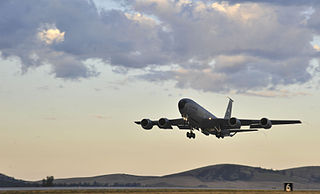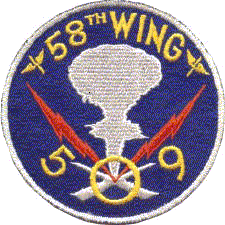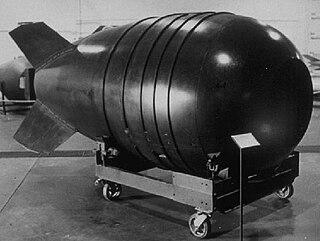Related Research Articles

Strategic Air Command (SAC) was both a United States Department of Defense (DoD) Specified Command and a United States Air Force (USAF) Major Command (MAJCOM), responsible for Cold War command and control of two of the three components of the U.S. military's strategic nuclear strike forces, the so-called "nuclear triad", with SAC having control of land-based strategic bomber aircraft and intercontinental ballistic missiles or ICBMs.

Fairchild Air Force Base (AFB) is a United States Air Force base, located approximately twelve miles (20 km) southwest of Spokane, Washington.

The Boeing B-47 Stratojet is a retired American long-range, six-engined, turbojet-powered strategic bomber designed to fly at high subsonic speed and at high altitude to avoid enemy interceptor aircraft. The primary mission of the B-47 was as a nuclear bomber capable of striking targets within the Soviet Union.

The North American B-45 Tornado was an early American jet-powered bomber designed and manufactured by aircraft company North American Aviation. It has the distinction of being the first operational jet bomber to enter service with the United States Air Force (USAF), as well as the first multiengine jet bomber to be refueled in midair.
This is a list of aviation-related events from 1958:

The Tybee Island mid-air collision was an incident on February 5, 1958, in which the United States Air Force lost a 7,600-pound (3,400 kg) Mark 15 nuclear bomb in the waters off Tybee Island near Savannah, Georgia, United States. During a practice exercise, an F-86 fighter plane collided with the B-47 bomber carrying the bomb. To protect the aircrew from a possible detonation in the event of a crash, the bomb was jettisoned. Following several unsuccessful searches, the bomb was presumed lost somewhere in Wassaw Sound off the shores of Tybee Island.

Hunter Army Airfield, located in Savannah, Georgia, United States, is a military airfield and subordinate installation to Fort Stewart located in Hinesville, Georgia.

Incirlik Air Base is a Turkish air base of slightly more than 3320 ac, located in the İncirlik quarter of the city of Adana, Turkey. The base is within an urban area of 1.7 million people, 10 km (6 mi) east of the city core, and 32 km (20 mi) inland from the Mediterranean Sea. The United States Air Force and the Turkish Air Force are the primary users of the air base, although it is at times also used by the Royal Air Force and the Royal Saudi Air Force. The base is also the home of the 74th Anti-aircraft Artillery Regiment of the Spanish Army.
Wassaw Sound is a bay of the Atlantic Ocean on the coast of Georgia, United States near Savannah at the mouth of the Wilmington River.

Wendover Air Force Base is a former United States Air Force base in Utah now known as Wendover Airport. During World War II, it was a training base for B-17 and B-24 bomber crews. It was the training site of the 509th Composite Group, the B-29 unit that carried out the atomic bombings of Hiroshima and Nagasaki.

The 509th Composite Group was a unit of the United States Army Air Forces created during World War II and tasked with the operational deployment of nuclear weapons. It conducted the atomic bombings of Hiroshima and Nagasaki, Japan, in August 1945.

The Mark 6 nuclear bomb was an American nuclear bomb based on the earlier Mark 4 nuclear bomb and its predecessor, the Mark 3 Fat Man nuclear bomb design.

Silverplate was the code reference for the United States Army Air Forces' participation in the Manhattan Project during World War II. Originally the name for the aircraft modification project which enabled a B-29 Superfortress bomber to drop an atomic weapon, "Silverplate" eventually came to identify the training and operational aspects of the program as well. The original directive for the project had as its subject line "Silver Plated Project" but continued usage of the term shortened it to "Silverplate".

The 7th Bomb Wing is a United States Air Force unit assigned to the Global Strike Command Eighth Air Force. It is stationed at Dyess Air Force Base, Texas, where it is also the host unit.

The United States Air Force's 341st Missile Wing is an intercontinental ballistic missile unit headquartered at Malmstrom Air Force Base, Montana. Up until 1 July 2008, it was designated as the 341st Space Wing.
Mars Bluff is an unincorporated community in Florence County, South Carolina, United States that bears the distinction of having been inadvertently bombed with a nuclear weapon by the United States Air Force.

The 701st Airlift Squadron is part of the 315th Airlift Wing at Charleston Air Force Base, South Carolina. It operates Boeing C-17 Globemaster III aircraft providing global airlift.

The Boeing B-52 Stratofortress is an American long-range, subsonic, jet-powered strategic bomber. The B-52 was designed and built by Boeing, which has continued to provide support and upgrades. It has been operated by the United States Air Force (USAF) since the 1950s. The bomber is capable of carrying up to 70,000 pounds (32,000 kg) of weapons, and has a typical combat range of around 8,800 miles (14,080 km) without aerial refueling.

The 1958 Mars Bluff B-47 nuclear weapon loss incident was the inadvertent release of a nuclear weapon from a United States Air Force B-47 bomber over Mars Bluff, South Carolina. The bomb, which lacked the fissile nuclear core, fell over the area, causing damage to buildings below. Though there was no nuclear detonation, six people were injured by the explosion of the bomb's conventional explosives. The Air Force was sued by the family of the victims, who received US$54,000, equivalent to $507,176 in 2021.
References
- ↑ "Armed Forces: Mars Bluff". Time . 24 March 1958. Retrieved 24 August 2014.
- ↑ Stephens, J (2012-07-25). "Mars Bluff Bomb". Florence County Museum . Retrieved 2015-09-30.